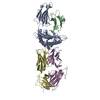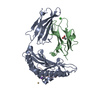[English] 日本語
 Yorodumi
Yorodumi- PDB-7u1r: SARS-CoV-2 Spike-derived peptide S1185-1193 K1191N mutant (RLNEVA... -
+ Open data
Open data
- Basic information
Basic information
| Entry | Database: PDB / ID: 7u1r | ||||||
|---|---|---|---|---|---|---|---|
| Title | SARS-CoV-2 Spike-derived peptide S1185-1193 K1191N mutant (RLNEVANNL) presented by HLA-A*02:01 | ||||||
 Components Components |
| ||||||
 Keywords Keywords | IMMUNE SYSTEM / human leukocyte antigen / major histocompatibility complex / HLA-A2 / HLA-A*02:01 / SARS-CoV-2 / Spike | ||||||
| Function / homology |  Function and homology information Function and homology informationantigen processing and presentation of peptide antigen via MHC class I / negative regulation of receptor binding / early endosome lumen / Nef mediated downregulation of MHC class I complex cell surface expression / DAP12 interactions / transferrin transport / cellular response to iron ion / Endosomal/Vacuolar pathway / lumenal side of endoplasmic reticulum membrane / Antigen Presentation: Folding, assembly and peptide loading of class I MHC ...antigen processing and presentation of peptide antigen via MHC class I / negative regulation of receptor binding / early endosome lumen / Nef mediated downregulation of MHC class I complex cell surface expression / DAP12 interactions / transferrin transport / cellular response to iron ion / Endosomal/Vacuolar pathway / lumenal side of endoplasmic reticulum membrane / Antigen Presentation: Folding, assembly and peptide loading of class I MHC / peptide antigen assembly with MHC class II protein complex / cellular response to iron(III) ion / MHC class II protein complex / negative regulation of forebrain neuron differentiation / antigen processing and presentation of exogenous protein antigen via MHC class Ib, TAP-dependent / ER to Golgi transport vesicle membrane / peptide antigen assembly with MHC class I protein complex / regulation of iron ion transport / regulation of erythrocyte differentiation / HFE-transferrin receptor complex / response to molecule of bacterial origin / MHC class I peptide loading complex / T cell mediated cytotoxicity / positive regulation of T cell cytokine production / antigen processing and presentation of endogenous peptide antigen via MHC class I / antigen processing and presentation of exogenous peptide antigen via MHC class II / positive regulation of immune response / MHC class I protein complex / positive regulation of T cell activation / peptide antigen binding / positive regulation of receptor-mediated endocytosis / negative regulation of neurogenesis / cellular response to nicotine / positive regulation of T cell mediated cytotoxicity / multicellular organismal-level iron ion homeostasis / specific granule lumen / phagocytic vesicle membrane / recycling endosome membrane / Interferon gamma signaling / Immunoregulatory interactions between a Lymphoid and a non-Lymphoid cell / negative regulation of epithelial cell proliferation / MHC class II protein complex binding / Modulation by Mtb of host immune system / late endosome membrane / sensory perception of smell / positive regulation of cellular senescence / tertiary granule lumen / DAP12 signaling / T cell differentiation in thymus / negative regulation of neuron projection development / ER-Phagosome pathway / protein refolding / early endosome membrane / symbiont-mediated disruption of host tissue / protein homotetramerization / Maturation of spike protein / Translation of Structural Proteins / Virion Assembly and Release / host cell surface / host extracellular space / viral translation / symbiont-mediated-mediated suppression of host tetherin activity / amyloid fibril formation / Induction of Cell-Cell Fusion / structural constituent of virion / intracellular iron ion homeostasis / entry receptor-mediated virion attachment to host cell / membrane fusion / Attachment and Entry / host cell endoplasmic reticulum-Golgi intermediate compartment membrane / learning or memory / positive regulation of viral entry into host cell / receptor-mediated virion attachment to host cell / host cell surface receptor binding / immune response / symbiont-mediated suppression of host innate immune response / receptor ligand activity / endocytosis involved in viral entry into host cell / endoplasmic reticulum lumen / Amyloid fiber formation / Golgi membrane / lysosomal membrane / fusion of virus membrane with host plasma membrane / external side of plasma membrane / focal adhesion / fusion of virus membrane with host endosome membrane / viral envelope / Neutrophil degranulation / symbiont entry into host cell / virion attachment to host cell / SARS-CoV-2 activates/modulates innate and adaptive immune responses / host cell plasma membrane / virion membrane / structural molecule activity / cell surface / endoplasmic reticulum / Golgi apparatus / protein homodimerization activity / extracellular space / extracellular exosome Similarity search - Function | ||||||
| Biological species |  Homo sapiens (human) Homo sapiens (human) | ||||||
| Method |  X-RAY DIFFRACTION / X-RAY DIFFRACTION /  SYNCHROTRON / SYNCHROTRON /  MOLECULAR REPLACEMENT / MOLECULAR REPLACEMENT /  molecular replacement / Resolution: 1.8 Å molecular replacement / Resolution: 1.8 Å | ||||||
 Authors Authors | Szeto, C. / Gras, S. | ||||||
| Funding support | 1items
| ||||||
 Citation Citation |  Journal: To Be Published Journal: To Be PublishedTitle: SARS-CoV-2 Spike-derived peptide S1185-1193 K1191N mutant (RLNEVANNL) presented by HLA-A*02:01 Authors: Szeto, C. / Gras, S. | ||||||
| History |
|
- Structure visualization
Structure visualization
| Structure viewer | Molecule:  Molmil Molmil Jmol/JSmol Jmol/JSmol |
|---|
- Downloads & links
Downloads & links
- Download
Download
| PDBx/mmCIF format |  7u1r.cif.gz 7u1r.cif.gz | 104.7 KB | Display |  PDBx/mmCIF format PDBx/mmCIF format |
|---|---|---|---|---|
| PDB format |  pdb7u1r.ent.gz pdb7u1r.ent.gz | 75.3 KB | Display |  PDB format PDB format |
| PDBx/mmJSON format |  7u1r.json.gz 7u1r.json.gz | Tree view |  PDBx/mmJSON format PDBx/mmJSON format | |
| Others |  Other downloads Other downloads |
-Validation report
| Summary document |  7u1r_validation.pdf.gz 7u1r_validation.pdf.gz | 458.2 KB | Display |  wwPDB validaton report wwPDB validaton report |
|---|---|---|---|---|
| Full document |  7u1r_full_validation.pdf.gz 7u1r_full_validation.pdf.gz | 460.5 KB | Display | |
| Data in XML |  7u1r_validation.xml.gz 7u1r_validation.xml.gz | 18 KB | Display | |
| Data in CIF |  7u1r_validation.cif.gz 7u1r_validation.cif.gz | 25.7 KB | Display | |
| Arichive directory |  https://data.pdbj.org/pub/pdb/validation_reports/u1/7u1r https://data.pdbj.org/pub/pdb/validation_reports/u1/7u1r ftp://data.pdbj.org/pub/pdb/validation_reports/u1/7u1r ftp://data.pdbj.org/pub/pdb/validation_reports/u1/7u1r | HTTPS FTP |
-Related structure data
| Related structure data |  1ogaS S: Starting model for refinement |
|---|---|
| Similar structure data | Similarity search - Function & homology  F&H Search F&H Search |
- Links
Links
- Assembly
Assembly
| Deposited unit | 
| ||||||||
|---|---|---|---|---|---|---|---|---|---|
| 1 |
| ||||||||
| Unit cell |
|
- Components
Components
-Protein , 2 types, 2 molecules AB
| #1: Protein | Mass: 40974.797 Da / Num. of mol.: 1 Source method: isolated from a genetically manipulated source Source: (gene. exp.)  Homo sapiens (human) / Gene: HLA-A, HLA Homo sapiens (human) / Gene: HLA-A, HLAProduction host:  References: UniProt: Q53Z42 |
|---|---|
| #2: Protein | Mass: 11879.356 Da / Num. of mol.: 1 / Fragment: UNP residues 21-119 Source method: isolated from a genetically manipulated source Source: (gene. exp.)  Homo sapiens (human) / Gene: B2M, CDABP0092, HDCMA22P Homo sapiens (human) / Gene: B2M, CDABP0092, HDCMA22PProduction host:  References: UniProt: P61769 |
-Protein/peptide , 1 types, 1 molecules C
| #3: Protein/peptide | Mass: 1043.155 Da / Num. of mol.: 1 / Fragment: RLNEVANNL / Mutation: K1191N / Source method: obtained synthetically Source: (synth.)  References: UniProt: P0DTC2 |
|---|
-Non-polymers , 6 types, 215 molecules 










| #4: Chemical | ChemComp-CD / |
|---|---|
| #5: Chemical | ChemComp-ZN / |
| #6: Chemical | ChemComp-NA / |
| #7: Chemical | ChemComp-ACT / |
| #8: Chemical | ChemComp-CL / |
| #9: Water | ChemComp-HOH / |
-Details
| Has ligand of interest | N |
|---|---|
| Has protein modification | Y |
-Experimental details
-Experiment
| Experiment | Method:  X-RAY DIFFRACTION / Number of used crystals: 1 X-RAY DIFFRACTION / Number of used crystals: 1 |
|---|
- Sample preparation
Sample preparation
| Crystal | Density Matthews: 2.42 Å3/Da / Density % sol: 49.08 % |
|---|---|
| Crystal grow | Temperature: 293 K / Method: vapor diffusion, sitting drop / Details: 18% P4000, 0.1M HEPES 7.6, 0.1M MgCl2, 1 mM CdCl2 |
-Data collection
| Diffraction | Mean temperature: 100 K / Serial crystal experiment: N | ||||||||||||||||||||||||||||||
|---|---|---|---|---|---|---|---|---|---|---|---|---|---|---|---|---|---|---|---|---|---|---|---|---|---|---|---|---|---|---|---|
| Diffraction source | Source:  SYNCHROTRON / Site: SYNCHROTRON / Site:  Australian Synchrotron Australian Synchrotron  / Beamline: MX2 / Wavelength: 0.954 Å / Beamline: MX2 / Wavelength: 0.954 Å | ||||||||||||||||||||||||||||||
| Detector | Type: DECTRIS EIGER X 16M / Detector: PIXEL / Date: Sep 22, 2021 | ||||||||||||||||||||||||||||||
| Radiation | Protocol: SINGLE WAVELENGTH / Monochromatic (M) / Laue (L): M / Scattering type: x-ray | ||||||||||||||||||||||||||||||
| Radiation wavelength | Wavelength: 0.954 Å / Relative weight: 1 | ||||||||||||||||||||||||||||||
| Reflection | Resolution: 1.8→47.47 Å / Num. obs: 49181 / % possible obs: 100 % / Redundancy: 7.3 % / Biso Wilson estimate: 29.16 Å2 / CC1/2: 0.998 / Rmerge(I) obs: 0.093 / Rpim(I) all: 0.037 / Rrim(I) all: 0.101 / Net I/σ(I): 11.8 / Num. measured all: 358594 / Scaling rejects: 18 | ||||||||||||||||||||||||||||||
| Reflection shell | Diffraction-ID: 1
|
-Phasing
| Phasing | Method:  molecular replacement molecular replacement | |||||||||
|---|---|---|---|---|---|---|---|---|---|---|
| Phasing MR | Model details: Phaser MODE: MR_AUTO
|
- Processing
Processing
| Software |
| ||||||||||||||||||||||||||||||||||||||||||||||||||||||||||||||||||||||||||||||||||||||||||||||||||||||||||||
|---|---|---|---|---|---|---|---|---|---|---|---|---|---|---|---|---|---|---|---|---|---|---|---|---|---|---|---|---|---|---|---|---|---|---|---|---|---|---|---|---|---|---|---|---|---|---|---|---|---|---|---|---|---|---|---|---|---|---|---|---|---|---|---|---|---|---|---|---|---|---|---|---|---|---|---|---|---|---|---|---|---|---|---|---|---|---|---|---|---|---|---|---|---|---|---|---|---|---|---|---|---|---|---|---|---|---|---|---|---|
| Refinement | Method to determine structure:  MOLECULAR REPLACEMENT MOLECULAR REPLACEMENTStarting model: 1OGA Resolution: 1.8→26.27 Å / Cor.coef. Fo:Fc: 0.96 / Cor.coef. Fo:Fc free: 0.955 / SU R Cruickshank DPI: 0.103 / Cross valid method: THROUGHOUT / σ(F): 0 / SU R Blow DPI: 0.105 / SU Rfree Blow DPI: 0.094 / SU Rfree Cruickshank DPI: 0.093
| ||||||||||||||||||||||||||||||||||||||||||||||||||||||||||||||||||||||||||||||||||||||||||||||||||||||||||||
| Displacement parameters | Biso max: 122.81 Å2 / Biso mean: 32.71 Å2 / Biso min: 15.27 Å2
| ||||||||||||||||||||||||||||||||||||||||||||||||||||||||||||||||||||||||||||||||||||||||||||||||||||||||||||
| Refine analyze | Luzzati coordinate error obs: 0.23 Å | ||||||||||||||||||||||||||||||||||||||||||||||||||||||||||||||||||||||||||||||||||||||||||||||||||||||||||||
| Refinement step | Cycle: final / Resolution: 1.8→26.27 Å
| ||||||||||||||||||||||||||||||||||||||||||||||||||||||||||||||||||||||||||||||||||||||||||||||||||||||||||||
| Refine LS restraints |
| ||||||||||||||||||||||||||||||||||||||||||||||||||||||||||||||||||||||||||||||||||||||||||||||||||||||||||||
| LS refinement shell | Resolution: 1.8→1.81 Å / Rfactor Rfree error: 0 / Total num. of bins used: 50
|
 Movie
Movie Controller
Controller


 PDBj
PDBj










